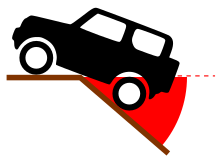Ramp angle
Ramp angle describes the ground clearance to be taken into account when driving a ramp when designing a vehicle, i.e. the angle up to which a vehicle can drive over a ramp at low speed without its underbody touching the edge of the ramp. Common methods of increasing the ramp angle, for example for off-road vehicles, are to raise the body with the addition of tires with a larger diameter.
A definition of the ramp angle can be found in the corresponding directive 92/53 / EEC :
"The ramp angle is the smallest acute angle between two planes at right angles to the central longitudinal plane of the vehicle, which are tangentially applied to the tires of the front wheels or the tires of the rear wheels under static load and whose intersection touches the rigid lower part of the vehicle outside the wheels . "
The maximum ramp angle r in degrees can be used with
are approximated, where z is the ground clearance and w is the wheelbase .
Colloquially, the ground clearance between the axles is also referred to as "belly clearance".

